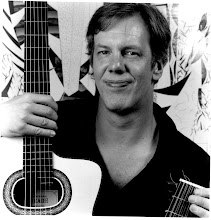 Like many of his contemporaries, Johnny Smith’s story is one of struggle from poverty, self-instruction, and incredible natural talent. Unlike his peers, Smith’s talents were extensive and not limited just to the guitar--he was equally at home on the trumpet.
Like many of his contemporaries, Johnny Smith’s story is one of struggle from poverty, self-instruction, and incredible natural talent. Unlike his peers, Smith’s talents were extensive and not limited just to the guitar--he was equally at home on the trumpet. Smith was born in
When the Great Depression closed the foundries, his family migrated first to
Within a short time Smith was playing six nights a week in a band called “Uncle Lem and the Mountain Boys.” This was a hillbilly band, complete with costumes, which traveled across
Around this time Smith discovered jazz, and his efforts changed to copying the big band music he heard on the radio and on records. By age 18, he felt he was ready to take on the jazz world, and he left the Uncle Lem to form the Airport boys, a jazz trio consisting of two guitars and a stand up bass. Smith arranged the music for the group, emulating the styles of his heroes Charlie Christian, Django Reinhardt, and Les Paul.
By 1942, his plans to storm the jazz scene abruptly change when the war required that every eighteen year old male deliver himself to the selective service office. Smith had always been interested in aviation (hence “Airport Boys’). So he enlisted in the Army Air Corps, the forerunner of the Air Force, with the intent of storming instead the enemy.
His less than perfect vision in one eye changed his life path in a very different direction. Instead of flying, he was assigned to the band. Since the military bands of the time had no guitar, the band leader handled him a cornet and an instruction book and told him to get busy or face the prospect of mechanics school.
Remarkably, Smith was able to progress to the point in two weeks that the band kept him. In short order Smith advanced to first chair cornet in the 364th Air Corps Band. In 1943, he was reassigned to the 8th Air Corps and ordered to assemble a jazz band. Finally he had a chance to use his guitar. Glenn Miller heard one of the performances and was so impressed that he tried to “requisition” Smith for his own band. Miller’s aircraft was lost over the
After the war, Smith secured work as a staff musician at the NBC radio affiliate in
The job at NBC in
Smith’s primary interest remained jazz and, after recording with Goodman in 1951, he formed his own jazz combo. The combo was in high demand, often playing engagements at Birdland that lasted as long as twenty-two weeks. Here Smith and his group shared the stage with jazz greats such as Charlie Parker, Thelonious Monk, Dizzy Gillespie, Bud Powell, Erroll Garner and Charles Mingus. He recalls that Parker would often come into the club on the nights that he played, sit at a table closest to him, and just listen. The original lineup of the Johnny Smithy Quintet included Stan Getz, another NBC musician, and sometimes Zoot Sims on saxophone. The affiliation with Smith launched Getz’ career.
The quintet’s 1952 recording for Roost Records of “Moonlight in Vermont” became one of the best-selling single in the jazz genre of all times, and established Smith once and for all at the top of the jazz world. It also made his trademark style of playing—smooth chord-arpeggio solos with incredibly fast runs interspersed—instantly recognizable to the general public. The opening chords of Smith’s solo on “
Johnny Smith, "Moonlight in Vermont" (with Stan Getz)
Another innovation in treating solos and chords is heard in "Lover Man." Near the end of the piece, it sounds as if there are two guitars--one holding the melody note and the second playing chords. It is in fact only Smith, and the effect is created by holding a finger on the high, sustained melody note while playing chords on the lower strings with his remaining left hand fingers!
The lure of jazz ultimately required Smith to rethink his employment, and he renegotiated a contract as freelancer at NBC so that he could play engagements with his quintet, and tour as featured artist, first with Stan Kenton’s band and then with Count Basie. In 1955, Smith composed a jazz ditty that would later and inadvertently become one of the best known of all surf anthems of the 1960s, “Walk, Don’t Run.” Those of you who play jazz standards will recognize the song as a reworking of "(I Leave You) As Softy as a Summer's Morning."
Johnny Smith, "Walk, Don't Run"
Mundell Lowe and Johnny Smith, "Seven Come Eleven"

No comments:
Post a Comment